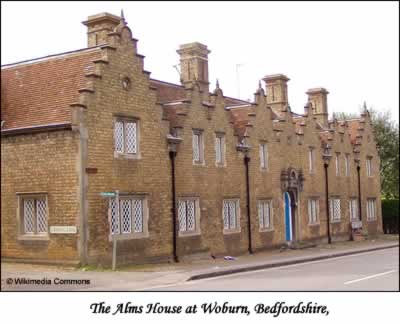Almshouses are European Christian institutions, the first ones being established in Britain from the 10th century. The first recorded almshouse in Britain was founded in York by King Athlestan.
They acquired their name from the tradition of alms giving to the poor. The almshouses were established in order for the (usually) elderly to remain within their community when they no longer had any means of paying rent, and thus giving them a measure of independence. In the Middle Ages

Almshouses were set up as charitable institutions and supported by donations and bequests from individuals, churches and the guilds. For example, the almshouses in Bedford Street, Woburn, Bedfordshire were founded in the will of Sir Francis Staunton in 1635, and were later granted to John Duke of Bedford and his heirs, by an Act of 1760. They were directed to erect twelve almshouses and provide £30 a year for the use of the inmates, and keep the same in repair.
Today, there are almost 1800 separate Almshouse Charities in the UK with 2,600 groups of Almshouses. There are over 30,000 Almshouse dwellings which provide accommodation for some 36,000 people. The support and help they provide is just as important now, as it was over 1000 years ago.
During my research, I found my paternal gx3 grandparents, Joseph and Mary Bradley, were living at No. 1 Rackfield Almshouses in Kidderminster in 1871 and Joseph was still there in 1881 although widowed by then. He is listed as a farm labourer.
In his will of 1630, Sir Edward Blount founded six houses which were to be for six aged men and their wives, who received £8 per annum each. His executors got off to a good start, building six houses near St Mary’s church at a cost of £100. The bequest, however, was £500, with the remaining money intended for land purchase to provide a maintenance income, but neither Sir Edward’s executors nor their heirs bought any land. They just enjoyed the use of the money for forty years, until the long arm of the Charity Commission caught up with them. The houses are shown on a map from 1753 but the houses were subject to a compulsory purchase order when the Staffordshire and Worcestershire Canal was cut in 1770. They were valued at £315 and replaced by new houses in Rackfields, on land donated by Thomas Foley. James Sheriff’s map of Kidderminster in 1780 shows Rackfield, with the new almshouses. These lasted for many years and were eventually demolished in 1954, when adjacent slum clearance undermined their foundations.

In 1881, Joseph’s immediate neighbour at number 2 was Hannah Tyler, a 92 year old widow, who had been a publican. She had also been living there in 1871. She is listed then as an innkeeper in almshouses! The other inhabitants of the almshouses had all changed since 1871. Living at No. 3 were Joseph and Ann Mason, aged 67 and 70 respectively, he was an agricultural labourer. They had their 19 year old granddaughter, Clara Ashcroft, who was a worsted winder, living with them. 69 year old widow, Mary Humphries, a charwoman, was living at number 4 with her son James who was an agricultural labourer. The occupants of number 5 were William and Jane Litchfield. He was aged 71, she was 66 and they were both listed as unable to work. The sixth occupants were William Robinson, aged 78, a carpet weaver, and his wife Hannah aged 74, formerly a mangler. It is interesting to see that most of the occupants of the houses had not been born in Kidderminster, or even Worcestershire. Joseph and Mary were both born in rural Shropshire and their daughter had been born there in about 1830. By 1842 they had moved to Kidderminster where their son was born. Presumably, like so many at the time, they had gone to the nearest town to find work.
Joseph and Mary were lucky to have found a home in the almshouses, since at that time there were only three sets of almshouses in the town. As far as we have been able to ascertain, they only had two children, a daughter who had married a miller and by 1871 was living in Staffordshire with her 6 children and a son who was a brewer’s drayman who married the daughter of a hand loom carpet weaver and by 1871 already had three children with one ‘one the way’. Although the son, Joseph, was living in Kidderminster in 1871 not far from Rackfields, by 1881 he was living in Staffordshire with his second wife and a further four children. Joseph senior died in 1883, still living at Number 1, Rackfields, but at least he did not have to go to the workhouse which will have been the ‘fate’ of many elderly people at the time.
Caroline
© Caroline 2009
SOURCES
Kidderminster Medical Society Newsletter No 41 – September 2005
Kidderminster Civic Society
FURTHER RESOURCES
Weavers’ Almshouse Charities
The Geffrye Museum: Almshouse ~Virtual Tour
Guildhall Library Manuscripts Section ~ List of Almshouses
The Nicholas Chamberlaine Almshouses, Bedworth